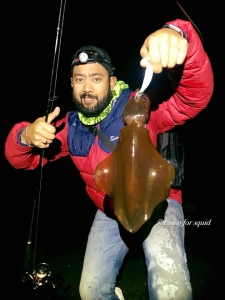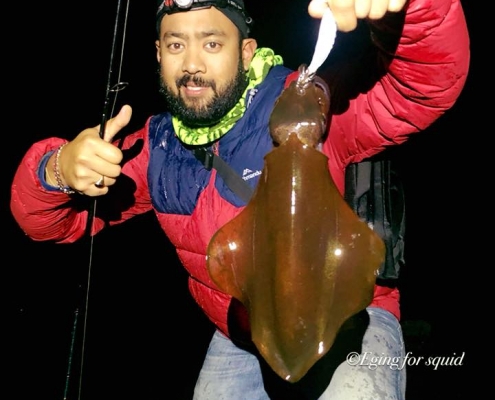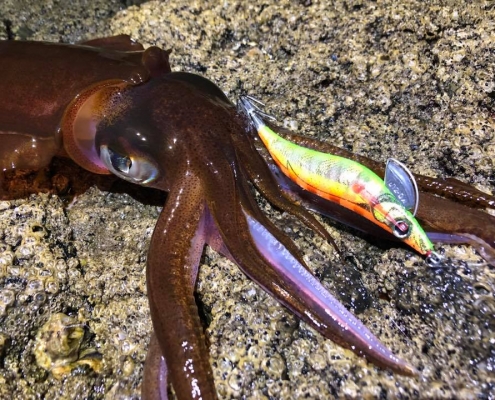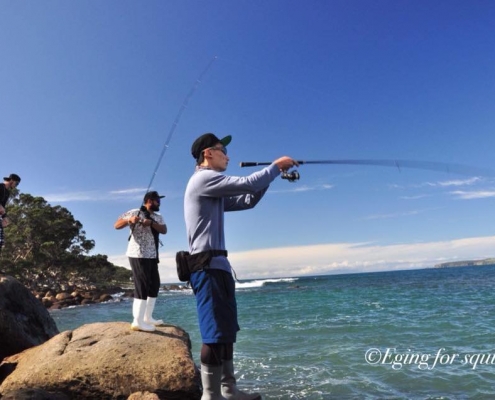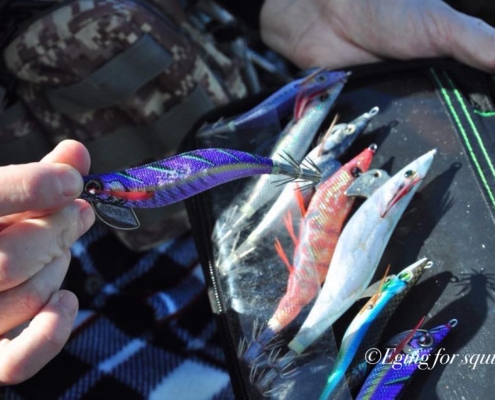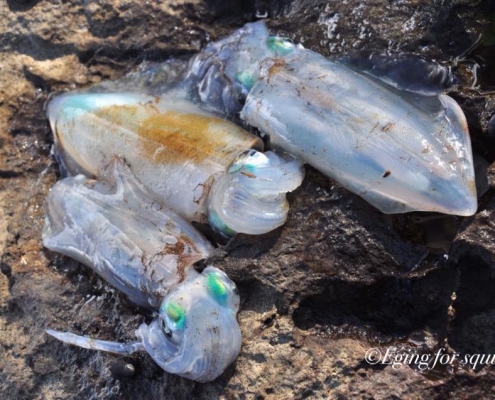“Eging for Squid” Facebook Page manager, Rudee Lim discusses gear options, jig types, techniques and location guidelines to get newbies started squid fishing with success.
Location
It’s vital to find habitat squid are likely to favour. Weedy areas with rock and consistent current are ideal because they provide cover with a ready supply of clean water and food. Depths ranging from 0.5 to five metres are suitable. If egi-ing in the dark, look for locations with plenty of artificial light as the squid will feed on the attracted baitfish.
Rod selection
Egi-ing rods are typically between seven and eight foot with an ultra-sensitive tip, which helps ensure subtle takes do not go unnoticed. The backbone of an egi-ing rod still needs to be stiff to impart the desired jig action in all conditions.
Reel and braid selection
Reels in the 2000-3000 size range work well loaded with dedicated egi braid from PE 0.8 to PE 1.5.
Egi-ing braid typically sinks easily to eliminate line belly. For leader, I favour one to 1.5 metres of 10lb to 20lb supple fluorocarbon. Fluorocarbon’s low refraction index helps fool the squid’s exceptional eyesight while its abrasion resistance is useful when fishing shallow weed and rock covered locations.
Squid Jigs
Choosing the appropriate squid jig is essential for Egi-ing success. It’s wise to have a range of sizes, colours and weights available as squid can get focused on a specific jig during a session, and I do find each location has its ace jig.
The three critical factors are as follows:
Size
Common egi jig sizes range from 2.0 to 4.5. The large 4.5 seems unnecessary for NZ waters; 2.5 to 3.5 is generally ideal.
Colour
Squid vision is monochromatic and thus they are unable to distinguish colour. They do see contrast and shades of grey very well. We’ve had great success when opting for natural prey colours during the day and darker tones at night. In the shallows, luminosity seems to have little effect with a consistent catch rate more reliant on the action of the jig.
Sink Rates
Egi-ing jigs come in a variety of sink rates, and there is no “ultimate jig” for every location.
The current and depth at the spot determine the sink rate – locations with stronger currents require faster sink rates. The size of the jig does not specify the sink rate. Look for it defined somewhere on the original box. For our fishing, a sink rate between three and five seconds per metre is about right.
Action
Two egi-ing actions dominate the modern school of thought, referred to as “twitching” or “whipping”.
A “twitching” action involves working the lure like a small prawn or shrimp darting through the water column. Cast the jig out, let it sink then flick the rod with a short wrist action vertically and slightly to one side to impart an upwards motion with a small wobble. Let the jig sink and reel in the slack and pause. Keep repeating until a take is detected, which often happens on the pause.
A “whipping” action is a more energetic process, where you cast the jig, let it reach the seabed then whip the rod upwards aggressively two to four times while reeling in the slack. The pause should be even longer than with the previous method before repeating the exaggerated whipping motion.
Summary
It’s an easy argument to put that suggests egi-ing for squid to be one of the most accessible and productive land-based fishing techniques in an urban environment. It works well day or night, and in surprisingly shallow water. The gear is generally less expensive than the heavier outfits required for snapper, and, as a table species, squid is both delicious and somewhat of a novelty.
For more information visit the “Eging for Squid” Facebook page. Details below.
About “Eging for Squid”
Managed by Rudee Lim, Jun Park and Ben Tupaea, “Eging for Squid” provides enthusiasts and those curious about the art of squid fishing, with a resource to explore the opportunities this small but growing community offers the kiwi angler.
“Eging for Squid” can be found on Facebook at www.facebook.com/egingforsquid , where fans will find gear tips, location advice, techniques, competitions and general discussion on all things egi-ing.

